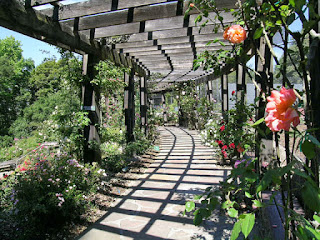 |
| California architect Bernard Maybeck was a master in building with wood, and nowhere better than in the pergola structure of his famed First Church of Christ, Scientist, Berkeley. |
A pergola is an outdoor structure that has two parallel rows of columns supporting a system of open roof beams. It’s more permanent than a trellis, arbor, or espalier, each of which is generally just a flimsy framework for plants to climb on. It's also a less formal structure than a gazebo, which usually has a radially symmetrical plan and a pitched roof.
I know it's January, but if you get started thinking about your pergola now, you can have it all finished and ready for summer.
Craftsman-era architects such as Bernard Maybeck and the brothers Greene well knew that a pergola extending from the house into the garden softened the transition between indoors and out, as well as providing a sensual respite from the hot sun. And indeed, on a hot summer day, a stroll beneath a graceful pergola overgrown with fragrant vines can be a memorable experience.
 |
| Stout columns with recessed panes are paired in this handsome and unusual pergola design. (Courtesy GardenStructure.com) |
The pergola’s columns should be substantial and not spindly—4x4s, for example, will look like toothpicks in the scale of the outdoors. While you can of course use off-the-shelf classical columns, it’s a lot more fun to come up with your own design. Try experimenting with hollow box columns, building them up to a substantial girth out of stock lumber. Because there’s so little actual material in these columns, you can lavish great detail on them at modest expense. Try adding moldings or decorative motifs, ceramic tile accents, or materials such as iron or copper. You can even incorporate lighting fixtures if you want to get fancy.
 |
| Heavy timber makes for a pergola that's both better looking and more resistant to the ravages of weather. (Courtesy of deedsdesign.com) |
 |
| Long curving pergola—this one in Berkeley's municipal rose garden—invites strollers to explore. (Berkeley, as you can see, is a sort of pergola nexus) |
The topmost members are usually installed “self-spaced” (having a gap equal to their own width between them). This provides a nice dappled mixture of shade and sun, and allows climbing plants to get a good grip.
 |
| A simple two-column pergola turns an ordinary gate into a genuine entrance. (Courtesy deedsdesign.com) |

No comments:
Post a Comment